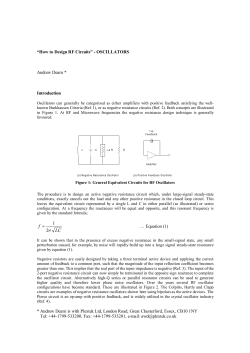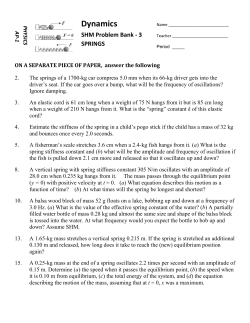
circadian clock
Coupling governs entrainment range of circadian clocks Abril 2015 Introduction Circadian clocks are endogenous oscillators that synchronize an organism to periodically recurring environmental conditions How? 1. periodic light detected by the eyes entrains (i.e. synchronizes) neurons in the bilateral SCN (the master clock in mammals) of the hypothalamus via neuronal signals 2. Within SCN tissue, individual neurons synchronize each other, generating self-sustained oscillations 3. SCN synchronizes other peripheral tissues Goals Theoretical and experimental study of which properties of circadian clocks influence the entrainment range (period, relaxation rate, coupling strength and ratio between zeitgeber strength and amplitude) This study will be made for the central circadian clock (SCN) and for a peripheral clock (lung) Amplitude and zeitgeber strength determine the entrainment range Figure1 A: Schematic representation of a circadian rhythm entrained by 24h temperature cycles Figure1 B: Schematic representation of entrainment region Oscillator characterized by its amplitude, intrinsic period and its stability with respect to amplitude perturbations (relaxation rate) Poincaré oscillator: A0: amplitude of oscillation \tau: intrinsic period \lambda: relaxation of amplitudes to the stable oscillation Relaxation rate affects range of entrainment, entrained amplitude and phase shifting properties Figure2 A: Numerically calculated entrainment region for Poincaré oscillator Figure2 B: Entrained amplitude of weak and rigid oscillators within the entrainment range The ratio of zeitgeber strength to oscillator amplitude detemines the range of entrainment Dots are numerically simulated lower limits of entrainment for a Poincaré oscillator with \lambda=1 h-1 Figure 3:The lower limit of entrainment (LLE) is plotted as a function of the ratio of zeitgeber strength to oscillator amplitude Conclusion: ratio between the zeitgeber strength and oscillator amplitude indeed determines the entrainment range for a given oscillator period and relaxation rate \lambda Lung tissue behaves as a weak oscillator and SCN as a rigid oscillator Weak, small-amplitude oscillators exhibit larger range of entrainment compared with rigid, high-amplitude oscillators Test these predictions experimentally: investigate entrainment of circadian oscillators using temperature as a zeitgeber (quasisquare-wave temperature profile ranging from 35.5ºC - cold - to 37ºC -warm) Two different cycles: 10h of cold and 10h of warm and 14h of cold and 14h of warm Tissue explants from PER2::LUC mice were subjected to temperature cycles and simultaneously monitored for bioluminescence rhythms Applied extreme temperature cycle (T=20h) but with increasing strength (0.75, 1.5, 3 and 6ºC temperature variation) Still no entrainment of SCN Repeat experience (T=22ºC) with even strengths (4, 6 and 8ºC temperature variation) stronger Entrainment of SCN for the two stronger strengths Coupling makes oscillators more rigid What is the fundamental difference between lung and SCN tissue that so profoundly affects entrainment behavior? Coupling of circadian rhythms can have a huge effect on the properties of oscillators Study two coupled Poincaré oscillators Coupling makes the synchronized oscillatory state more rigid in two aspects: (i) resonance increases the amplitude (Figure A); (ii) coupling leads to faster relaxation (Figure B) Coupling makes the system harder to entrain Reducing coupling faciltates entrainment of SCN tissues Test experimentally predictions (attenuating coupling makes the coupled system weaker and so enlarges entrainment range) - reduce pharmacologically coupling in SCN slices taken from PER2-LUC mice (drug: MDL) MDL reduces cellular coupling with no detectable effect on relative amplitude MDL treated SCN slices entrain to temperature cycle in a MDL dosedependent manner. Conclusion: subjecting SCN slices to decoupling agents leads to expanded entrainment range Lung is probably a weak oscillator, likely because a lack of coupling leads to a slow amplitude relaxation and SCN is a rigid oscillator, whereby coupling probably are the main causes for this rigidity. Why is the SCN designed to be a stronger circadian oscillator than peripheral organs?
© Copyright 2025










